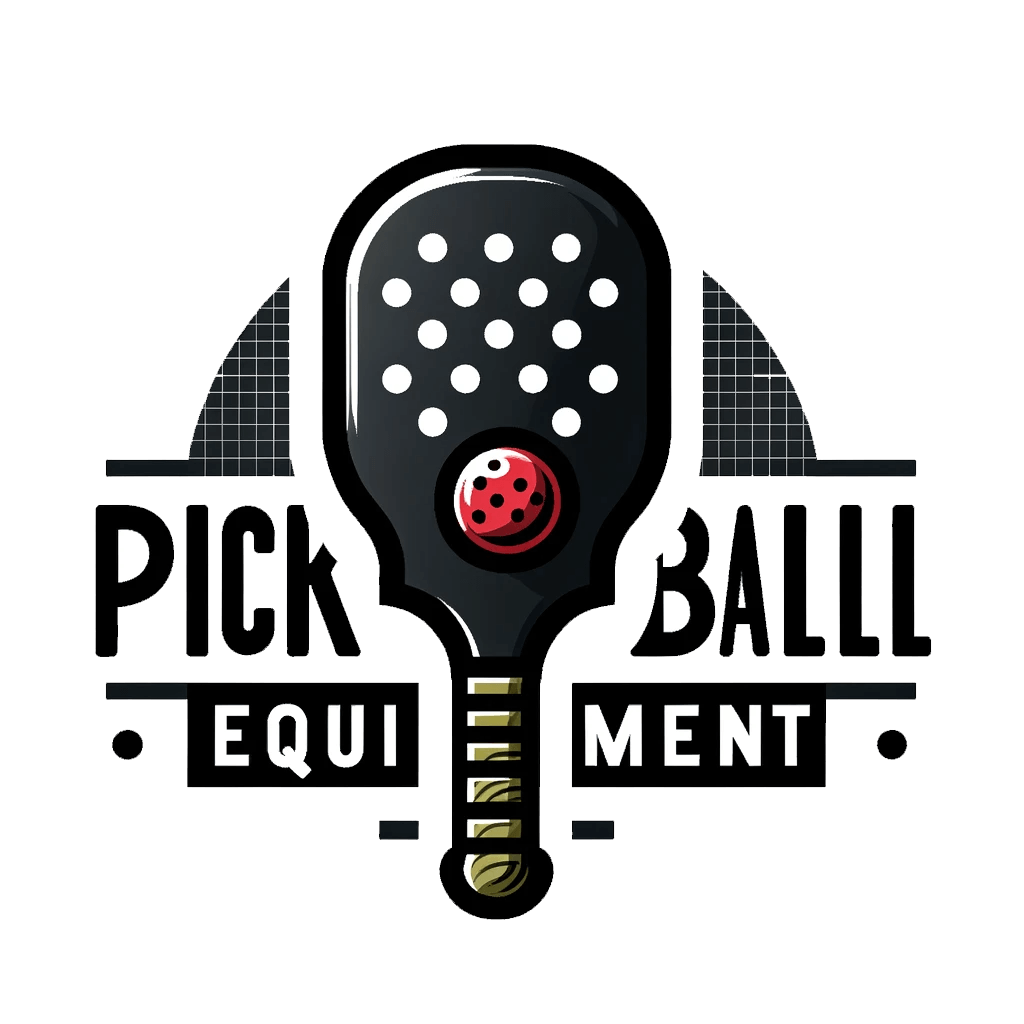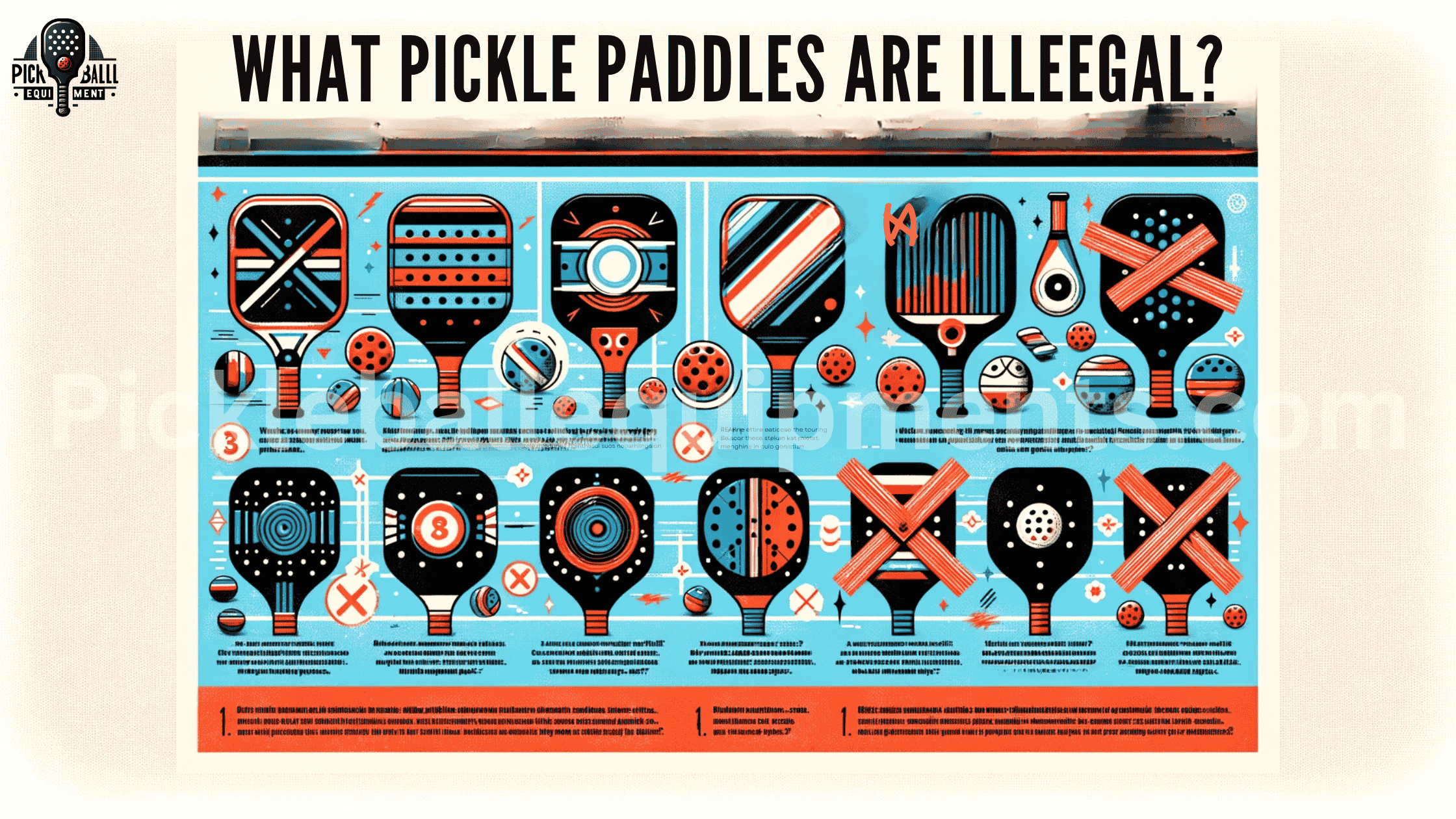Players must understand the rules for pickleball paddles to keep the game fair and honest. No matter where you play, make sure your paddle meets all the requirements. Using approved equipment in pickleball tournaments ensures fair play and eliminates unfair advantages. Players must test their equipment to ensure it meets the club’s rules before joining a tournament.
Pickleball paddles that have not received USAPA approval are illegal and risk failing court tests, making them non-compliant. Some examples of issues are holes, loud noises, or changes that make the game unfair. For example, a club might have holes in the walls or excessive noise from the speakers. Additionally, players may use modified equipment, such as a right paddle, to gain an unfair advantage. To make sure a paddle meets the standards, we conduct example tests for compliance. We will discuss these tests in detail and provide examples of what constitutes an illegal paddle.
In recent years, the use of illegal pickleball paddles has caused controversy. Clubs and events are now taking action against them. Players can help maintain fair play and preserve the spirit of the sport by understanding what makes a paddle legal or illegal.
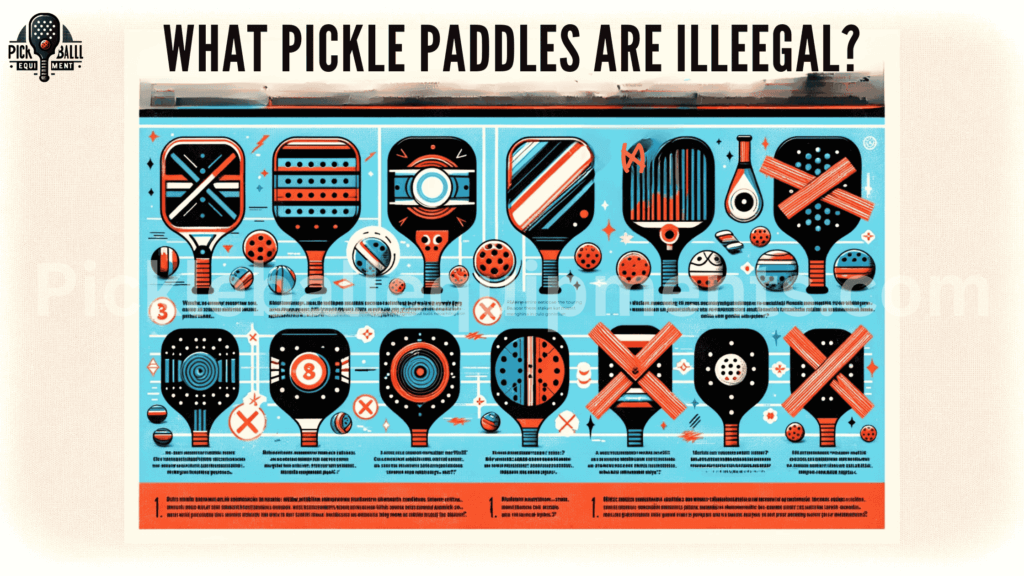
Understanding the Criteria for an Illegal Pickleball Paddle
It’s essential to understand what makes a paddle legal or illegal. The governing body of the sport, USA Pickleball, has set specific criteria that paddles must meet to be deemed legal for play. Not following these rules can lead to being disqualified from tournaments and unfair advantages in casual games. It is important to use the right paddle to avoid any penalties or advantages.
Size and Weight Restrictions
Legal pickleball paddles have maximum dimensions that they must adhere to. The official rules state that a paddle’s length and width cannot exceed 17 inches. The total length of the paddle, including the handle, should not exceed 24 inches. To ensure fair play, all players must use paddles that meet the size restrictions. This rule keeps everyone’s equipment consistent.
Weight limitations are also imposed on paddles to ensure a level playing field. The rules specify that a paddle must weigh no more than 14 ounces. To keep things fair, players can’t use super heavy paddles that make it harder to move.
The size and weight of a pickleball paddle directly affect gameplay and player performance. A larger surface area allows for greater reach and improves shot placement accuracy. On the other hand, lighter paddles offer increased maneuverability and quicker reaction times at the expense of power.
If you use a paddle that is too big or heavy, you might get disqualified from tournaments or be seen as unfair in casual games. Players must follow these rules to ensure fair competition and consistent gameplay in all matches.
Surface Requirements
To be considered legal, a pickleball paddle must have a solid surface without any holes or indentations. To be fair, this rule stops players from using textured surfaces to control the ball better.
Different types of surfaces used in paddle construction can impact gameplay significantly. Smooth surfaces tend to provide less grip on the ball, resulting in less spin and control. Textured surfaces give players a better grip, so they can generate more spin and control the ball’s path.
To ensure fairness in pickleball matches, approved paddles must have a consistent playing surface. Players who follow these rules can make sure everyone uses equipment that performs equally well.
Materials and Construction Guidelines
USA Pickleball has approved certain materials for use in manufacturing legal pickleball paddles.
Identifying USAPA Approved Pickleball Paddles
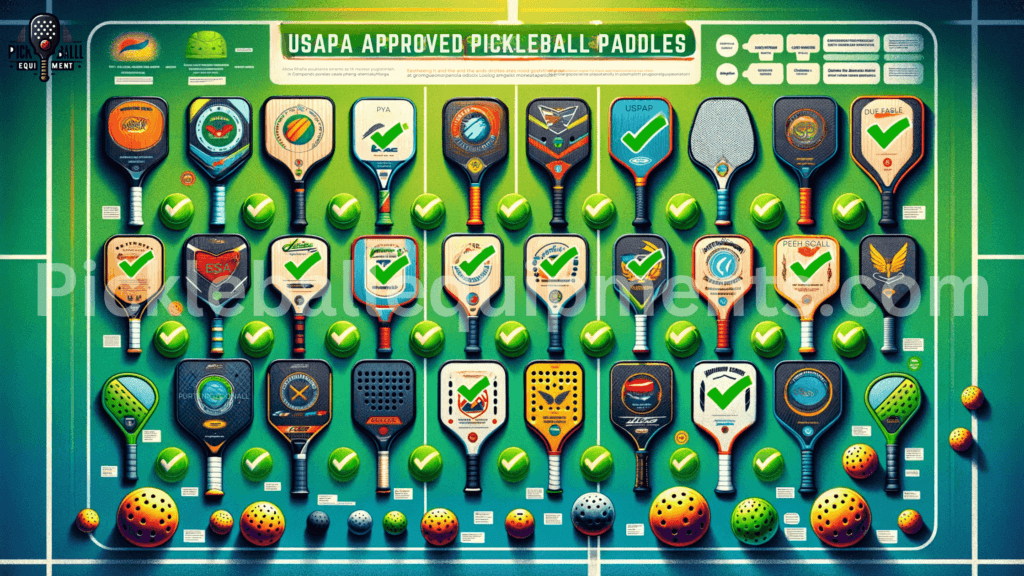
The USA Pickleball Association keeps a list of approved pickleball paddles for official events. Before buying a pickleball paddle, make sure to check the USAPA approved list for standards.
The Approval Process
The Approval Process involves a thorough evaluation of pickleball paddles to ensure they meet the standards set by the USAPA. Paddles must be on the approved list maintained by the USAPA to be considered legal for use in sanctioned events. To make sure it follows the rules, this process tests and assesses different things like design and performance.
Recognizing USAPA Stamps
The USAPA accepts paddles approved by them for official events. To ensure a paddle meets the guidelines set by the association, look for the USAPA-approved decal or stamp on it. If your paddles don’t have a USAPA-approved decal or stamp, they might not be allowed in professional matches or on the court.
Where to Find Approved Paddles
The USAPA gives a list of approved paddles for tournaments and events. It is crucial to refer to the official rules and guidelines set by USAPA when choosing a paddle. Before you join a USAPA event or tournament, check if your pickleball paddle is approved.
Factors Affecting the Legality of Pickleball Paddles
Pickleball paddles come in various materials, sizes, and weights. However, not all paddles are considered legal for play. The legality of pickleball paddles can be influenced by different factors. These factors include the materials, size, weight restrictions, and paddle designs.
Customization Limitations
To keep the game fair, pickleball paddles have limits on customization to maintain integrity. Pickleball organizations have rules about changing equipment, like paddles and balls. The rules include paddle size, materials, texture, and decals to keep the game fair.
For instance, USA Pickleball (USAPA) has specific rules regarding paddle dimensions. Paddles must adhere to a maximum length of 17 inches and width of 7 inches. There are restrictions on the thickness or depth of the paddle’s core material. Any modifications that exceed these limits would render a paddle illegal for competitive play.
Court-Specific Bans
At official events or tournaments, some pickleball courts may not allow certain types of paddles. The bans make sure the game is fair for all players no matter where they play.
The rules for pickleball tournaments say which paddles are allowed and which are not. Players in these tournaments must know the rules beforehand to avoid using illegal paddles by accident.
Scrutiny on Unique Paddle Designs
USA Pickleball examines unique paddle designs to make sure they meet the requirements. In recreational play, you can be yourself. But, if you change your paddle, you can’t play in tournaments.
For example, adding an edge guard or applying a paint job might alter a paddle’s characteristics beyond permissible limits. If you want to play in tournaments, pay attention to the paddle rules from USA Pickleball. To prevent disqualification in competitions, players must meet paddle requirements for their equipment.
Limitations on Customizing Pickleball Paddles
When you customize pickleball paddles, the USA Pickleball Association has rules and limitations. These regulations are in place to ensure fair play and maintain a level playing field for all participants. Players should know these limitations before changing their paddles.
Foam Core Paddles Not Allowed in Tournaments
Players should be aware that foam core paddles are generally not allowed in official tournaments. This restriction is due to the potential for foam core paddles to alter the flight characteristics of the ball. The USAPA found that foam cores make the ball spin too much, which can affect the game and give players an unfair advantage. To play in tournaments, players must use paddles that follow the association’s rules.
Ensuring Compliance with Specifications
To customize pickleball paddles, players must follow the rules of the USA Pickleball Association. These rules apply whether they’re playing for fun or in a tournament. You must follow the rules for functional changes, but you can still include personalization and aesthetics.
Modifying the paddle’s design or texture affects its compliance with official specifications. These alterations may affect how a paddle performs during gameplay and its ability to pass required tests. Changes to the paddle’s surface or size can also affect compliance and integrity when playing.
It’s worth noting that guidelines for recreational play differ from those for tournament play. Changes that are okay in casual games might not be allowed in official competitions. This is because they want to make sure everything is fair and consistent for everyone.
List of Banned Pickleball Paddle Models
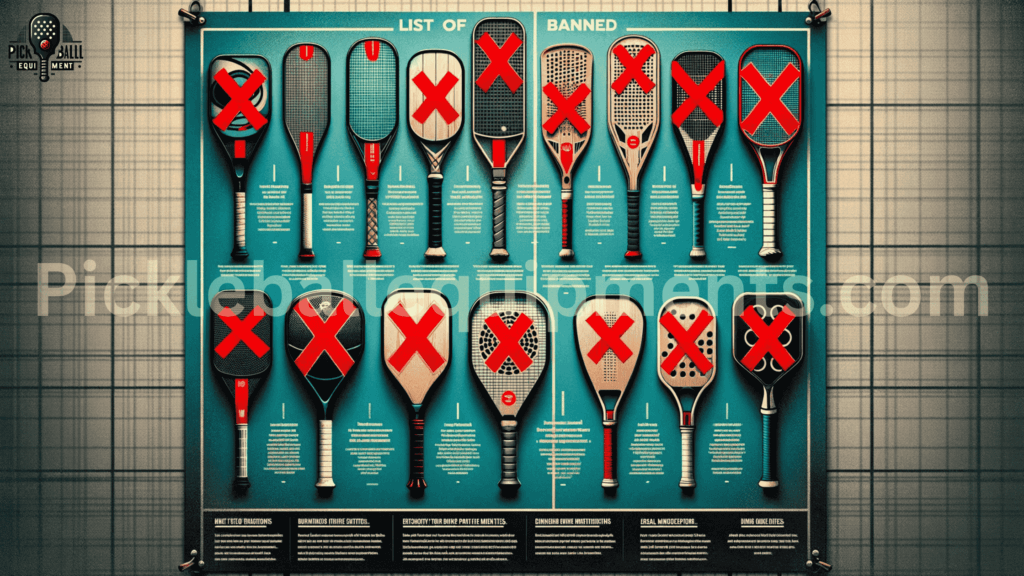
Recent changes have been made to the approved list of pickleball paddles by the USA Pickleball Association (USAPA). These changes include adding certain paddle models to the banned list. Players in sanctioned events must know updates to use a legal paddle and avoid disqualification or penalties.
Recent Additions to the Banned List
The USAPA regularly checks and updates the list of approved pickleball paddles. Some models are now banned because of recent additions. These additions are important because they affect players who take part in official events. Players should check their paddle against the official ban list before competing to follow the rules.
Impact on Sanctioned Events and Tournaments
Certain paddle models are now banned. Players must understand how this affects their participation in events. If you use a paddle that’s not allowed, you might get disqualified or penalized. This can really hurt your performance and chances of winning. Therefore, it is vital for players to stay up-to-date with the latest changes in order to compete fairly.
Modifications that Render Paddles Illegal
Players should be aware that changing paddle designs or materials might make them illegal for games. The USAPA sets strict standards regarding paddle construction, weight, dimensions, and other specifications. Any modifications that deviate from these guidelines may result in a paddle being deemed illegal.
Players should be careful about changing their pickleball paddles in a way that breaks the rules. You can make changes to your paddle by adding or altering holes, grip material, or core material.
Reasons Behind the Bans
Governing bodies like USAPA ban certain pickleball paddles to ensure fairness for all players. They want to maintain a level playing field. You cannot use paddles that give an unfair advantage or change the game in sanctioned events.
Paddles can get banned if they have design features that give players an unfair advantage. This can include paddle designs that enhance spin, control, or power beyond what is considered acceptable within the rules.
Paddles with holes that do not meet official specifications or pass required tests may also be deemed illegal.
Overview of CRBN Pickleball Paddles Controversy
The CRBN pickleball paddles have caused a big controversy in the pickleball community. Certain pickleball tournaments have banned these paddles, even though recreational players love them. The governing body for pickleball in the USA declared them ineligible for tournaments. They didn’t meet the required specifications.
The main issue with CRBN paddles lies in their foam core construction. This design gives players an unfair advantage, but it violates the approved guidelines by USA Pickleball. As a result, these paddles have faced scrutiny and are considered illegal for competitive play.
Analysis of the Controversy’s Impact
The debate about illegal pickleball paddles raises concerns about fairness in tournaments. Using paddles like these might give players an unfair advantage, which could affect match results and hurt the game’s fairness.
Tests by experts show that paddle changes can make noise and cause glare on courts. These factors not only disrupt gameplay but also violate approved guidelines for tournament play. Allowing illegal paddles could compromise the playing environment and create unfair conditions.
Future Implications for Paddle Manufacturers
Paddle manufacturers need to stay current with USA Pickleball’s rules to follow the law. If you don’t follow the rules, you could get disqualified from tournaments. This applies to players using illegal paddles and manufacturers making non-compliant products.
Retailers selling pickleball paddles should avoid legal issues and harming their reputation. Before selling products, they must make sure they follow all regulations.
Impact of Illegal Pickleball Paddles on the Game
Using illegal pickleball paddles can have a big impact on the game, including casual play and official tournaments. These paddles can give players an unfair advantage. They let players generate too much spin or manipulate the ball in ways not allowed by the rules. Using unauthorized pickleball paddles in official tournaments can lead to disqualification and fines. This goes against the regulations set by the governing body.
Fair Play Concerns
Players who use illegal pickleball paddles gain an unfair advantage, which damages the game’s integrity. It allows them to gain an upper hand by generating excessive spin or manipulating the ball beyond what is allowed within the official rules. This undermines fair competition and creates an unbalanced playing field.
In official pickleball tournaments, fair play is crucial, and strict adherence to the rules is expected. Illegal paddles cause issues by disrupting fair competition and questioning event integrity. To make sure everyone has a fair chance, players need to follow the rules and use approved gear.
Even in casual recreational play, using illegal paddles goes against the spirit of the game. Pickleball is known for its friendly and inclusive nature, where players come together to enjoy a fun and fair match. But when people use illegal equipment to gain an unfair advantage, it ruins the fun and makes the game unfair for everyone.
Player Safety Issues
Ensuring safety is very important in pickleball, whether playing for fun or professionally. That’s why there are strict paddle guidelines. Pickleball paddles that are illegal might be dangerous for players. They don’t follow the rules set by USA Pickleball.
When playing in USA Pickleball tournaments or events, all pickleball paddles must pass tests to meet standards. To keep players safe and ensure fair competition, these tests have rules for holes and ball deflection. Paddles that are not legal could hurt people while they are playing.
Regulatory Challenges
Pickleball associations and organizations have different guidelines and rules, which makes regulation challenging. The rules for pickleball paddles can vary at different courts, tournaments, and events. This inconsistency leads to confusion among players and retailers alike.
USA Pickleball’s Role in Regulating Paddles
USA Pickleball plays a crucial role in regulating pickleball paddles. They set guidelines and standards for paddle construction to ensure fair play in tournaments. These regulations are put in place to maintain a level playing field for all players and uphold the integrity of the game.
Legal paddles must meet specific size, material, and performance requirements, as stated in the rules. By doing so, they aim to prevent any unfair advantages that may arise from using certain types of equipment.
Efforts to Combat Illegal Equipment
Pickleball governing bodies have set rules to stop illegal equipment in events and tournaments. If players make their paddles better using lead tape or changing the edge guard, it’s against the rules.
Retailers also play a crucial role in preventing the sale of illegal pickleball paddles. They are responsible for ensuring that the paddles they sell meet the required specifications set by USA Pickleball. Retailers help keep the sport fair by telling customers the effects of using illegal equipment.
Approval Process for New Designs
There is an approval process in place. The United States of America Pickleball Association (USAPA) evaluates thoroughly to ensure compliance.
To be on the approved paddle list, design changes must follow USAPA guidelines and specifications. Paddle makers send their designs for tests. These tests include checking how they perform on the court, inspecting the materials used, and evaluating the texture. Only those designs that meet these necessary requirements are granted approval.
By implementing this approval process, USA Pickleball aims to maintain consistency and fairness in the game. It makes sure all players can use equipment that meets the set standards. This creates a fair playing field for everyone.
Identifying Illegal Pickleball Paddle Models to Avoid
To play fair and keep events honest, make sure you know the rules for USA Pickleball. To identify illegal pickleball paddles, follow these guidelines for tournaments or recreational play.
When determining a pickleball paddle’s legality, one must consider the materials used. The governing bodies might ban foam core paddles, like certain types, for spinning too much or having other advantages. It’s important to be aware of these material restrictions to avoid using an illegal paddle during tournament play.
Another factor to pay attention to is the design of the paddle’s edge guard. Some models may have an extended or modified edge guard that is not permitted in official tournaments or recreational play. USA Pickleball guidelines specify that the edge guard should not extend beyond the face of the paddle. By checking this feature, you can ensure that your paddle adheres to the regulations and remains compliant.
Now let’s explore some sample models and their violations according to USA Pickleball standards. The rules for the sport of pickleball say how the paddle should be made. This includes its size, noise, and design. Example models that violate these guidelines often fail tests related to these aspects.
In tournaments, players must know the official guidelines for paddle size, hole patterns, and more. This knowledge will help you make informed decisions when selecting a pickleball paddle for your game.
So how can you spot a non-compliant pickleball paddle? One way is by checking its edge guard. If the edge guard extends past the paddle’s face, it might be illegal in pickleball.
Consider evaluating the material used in your pickleball paddle. Foam core paddles are not allowed in official pickleball tournaments. Ensure that your paddle does not have a foam core to avoid disqualification.
Conclusion
In summary, players who want to compete within the rules must understand what makes a pickleball paddle illegal. This article provides important info about what affects the legality of pickleball paddles. The document discusses USAPA approval, sets limits on customization, and bans certain paddles. The community has brought the controversy surrounding CRBN pickleball paddles to attention. Illegal paddles can greatly affect the game.
To play fair and keep the sport’s integrity, players must learn the rules set by organizations like USA Pickleball. To make pickleball fair and fun, use approved paddles instead of illegal ones. Remember, always stay informed and make responsible choices.
Frequently Asked Questions
A pickleball paddle becomes illegal if it violates the regulations established by the sport’s governing bodies. There are many factors that can make a paddle illegal, such as excessive size, a rough surface, or the inclusion of prohibited materials.
To play pickleball, your paddle must meet the standards set by organizations such as the USA Pickleball Association. Look for approved dimensions, weight limits, and acceptable materials to verify compliance.
Yes, according to USAPA rules, a legal pickleball paddle must not exceed 17 inches in length and 7.25 inches in width. It should have a maximum total thickness of 0.875 inches and an edge guard height limit of 1/2 inch.
Absolutely. The surface texture of a pickleball paddle plays a crucial role in determining its legality. If your paddle is too rough or uneven, it could be considered illegal. This is because it gives you an unfair advantage and changes how the ball spins.
Some materials cannot be used in pickleball paddles because they may affect fairness or safety. These typically include metal cores or inserts and any substance that could cause excessive deflection or damage to the ball.
